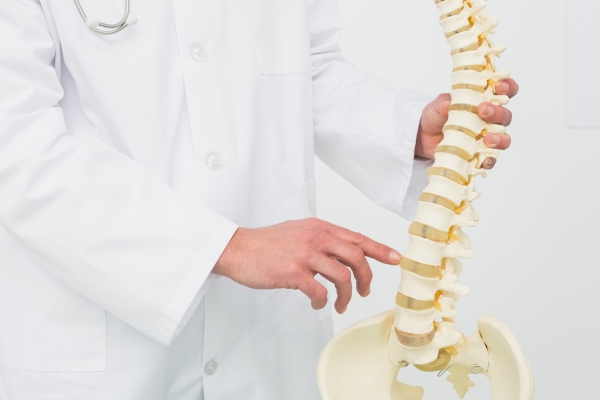What is cauda equina syndrome?
Cauda equina syndrome (CES) occurs when the nerve roots of the cauda equina (horse’s tail in Latin) are compressed and disrupt motor and sensory functions of the lower extremities and bladder. CES may be caused by spinal fractures, cancer or herniated spinal disc amongst others. If this condition is left untreated, it can lead to serious complications such as paralysis and loss of bladder control.
This condition is estimated to affect 1 in 33,000-100,000 people. In addition CES affects both males and females equally. Furthermore, it occurs primarily in adults although trauma can affect people of all ages. Unfortunately, there is a small percentage of people who have undergone surgery for lumbar herniated disc develop CES afterwards.
What are the causes of cauda equina syndrome?
The causes of cauda equina syndrome include:
- Herniated disk: A herniated disk is one of the most common causes of CES. A disk is like a cushion between your vertebrae and it is made up of a jelly-like interior and a tough exterior.
- Spinal trauma and fracture: Spinal trauma and spinal fractures can lead to CES if the cauda equina is damaged.
- Spinal infection or abscess: These may cause compression of the spinal cord at the level of the cauda equina leading to CES symptoms. These infections include tuberculosis, herpes simplex virus, meningitis, meningovascular syphilis, schistosomiasis and cytomegalovirus.
- Spina bifida: Spina bifida is a birth defect that occurs when the spine and spinal cord does not form properly.
- Cancer or spinal tumours: CES may be caused by primary or metastatic (spreading of a cancer) spinal tumours. Cancers that may spread to the spinal cord and lead to CCES include renal cell carcinoma, lung cancer, breast cancer, lymphatic cancer and colorectal cancer (cancer of the large intestines and rectum).
- Complications after spinal surgery.

Other rare causes of CES include:
- Spinal haemorrhages.
- Multiple sclerosis.
- Intravascular lymphomatosis.
- Deep venous thrombosis of the spinal veins.
- Inferior vena cava thrombosis.
- Congenital anomalies of the spine.
What are the risk factors for cauda equina syndrome?
There are several factors which may increase your risk of developing CES and these include:
- Advanced age.
- Athletes participating in high-impact sports.
- Being overweight or obese.
- Occupational risks such as a job requiring heavy lifting, pushing, twisting and bending sideways.
- A history of severe back injury due to a car accident or a fall.
What are the signs and symptoms of cauda equina syndrome?
The signs and symptoms of CES varies in severity and take a long time to develop. These include:

- Difficulty holding or releasing urine (incontinence).
- Loss of sensation in the upper parts of the legs, buttocks, feet and heels.
- Intense lower back pain.
- Weak or pain in one or both legs.
- Loss of reflexes in your lower limbs.
- Erectile dysfunction.
There are other conditions which resemble CES which your doctor while rule out before making a diagnosis, these include:
- Diabetic neuropathy.
- Acute inflammatory demyelinating polyradiculoneuropathy.
- Guillain-Barre syndrome.
- Multiple sclerosis.
- Cancer of the spinal cord.
- Spinal cord infections.
- Traumatic peripheral nerve lesions.
- Neurosarcoidosis.
- Amyotrophic lateral sclerosis (ALS).

Making a diagnosis
To make a diagnosis, your doctor will first take a detailed history from you to know more about your symptoms. After the history taking, your doctor will perform a thorough physical examination to look for signs of CES. To confirm the diagnosis, your doctor will order some tests and these include:
- Blood studies: The blood studies include Complete Blood Count (CBC), electrolytes, blood urea nitrogen (BUN) and creatinine- these are done to rule out anaemia, infection and renal dysfunction. Erythrocyte Sedimentation Rate (ESR) is elevated if there is presence of inflammatory processes in the body. In addition, a test for syphilis is done to rule syphilis infection.
- Radiography: It is unlikely that plain radiography will help in the diagnosis of CES, but it may prove to be useful in cases of traumatic injury, narrowing of the spinal canal or spinal fractures. In addition, chest radiography may be done to rule out any lung disease which could affect the spine such as lung cancer for example.
- Magnetic Resonance Imaging (MRI) scan: An MRI scan of the spine is the diagnostic test of choice in the diagnosis of CES. It is superior to Computed Tomography (CT) scan of the spine. In addition, it does not involve ionizing radiation.
- Needle electromyography (EMG): An EMG may be done to assess for nerve damage.

What are the treatments for cauda equina syndrome?
After CES diagnosis, surgery is required to relieve the pressure on the nerves. If the cause of the CES symptoms is a herniated disk, surgery may be performed to remove the offending material pressing on the cauda equina. Surgery should be perform within 24-48 hours if serious symptoms- severe back pain, loss of reflexes in your lower extremities, sudden loss of sensation in on or both leg and recent onset of rectal or urinary incontinence- arises. This will prevent irreversible nerve damage and disability.
After surgery, physical therapy will help you to improve your range of motion and strengthen your muscles. In addition to physical therapy, there are other therapies available to help you increase your quality of life and ability to perform activities of daily living without any help.

Your doctor will prescribe medications to relieve your pain such as ibuprofen, oxycodone and corticosteroids- to reduce inflammatory processes and swelling. In addition, your doctor will also prescribe medications for better bowel or bladder control such as oxybutynin and tolterodine.
What are the complications of cauda equina?
If CES is left untreated, the following complications may ensue:
- Erectile dysfunction in men.
- Loss of function of lower limbs.
- Pressure ulcers in bedridden people.
- Loss of bone mass (osteoporosis).
- Bowel or bladder incontinence.
Expectations (prognosis)
If diagnosed early and treated proper, some people with CES may recover full function of the lower limbs while some people do not. After surgery, some or all of your senses and motor control may be slow in returning- bladder function being the last to fully recover. Unfortunately, it may take months to a couple of years to recover.

Source:
J. Alastair, I. and Simon, M., 2016. Davidson's Essentials of Medicine. 2nd ed. London: ELSEVIER.
Parveen, K. and Michael, C., 2017. Kumar & Clarks Clinical Medicine. 9th ed. The Netherlands: ELSEVIER.
Morrison, W. 2018. What is cauda equina syndrome.
Dawodu, S. 2018. Cauda Equina and Conus Medullaris Syndromes.
Mauffrey C, Randhawa K, Lewis C, Brewster M, Dabke H. Cauda equina syndrome: an anatomically driven review. Br J Hosp Med (Lond). 2008 Jun. 69(6):344-7.
Rogers WK, Todd M. Acute spinal cord injury. Best Pract Res Clin Anaesthesiol. 2016 Mar. 30 (1):27-39.









